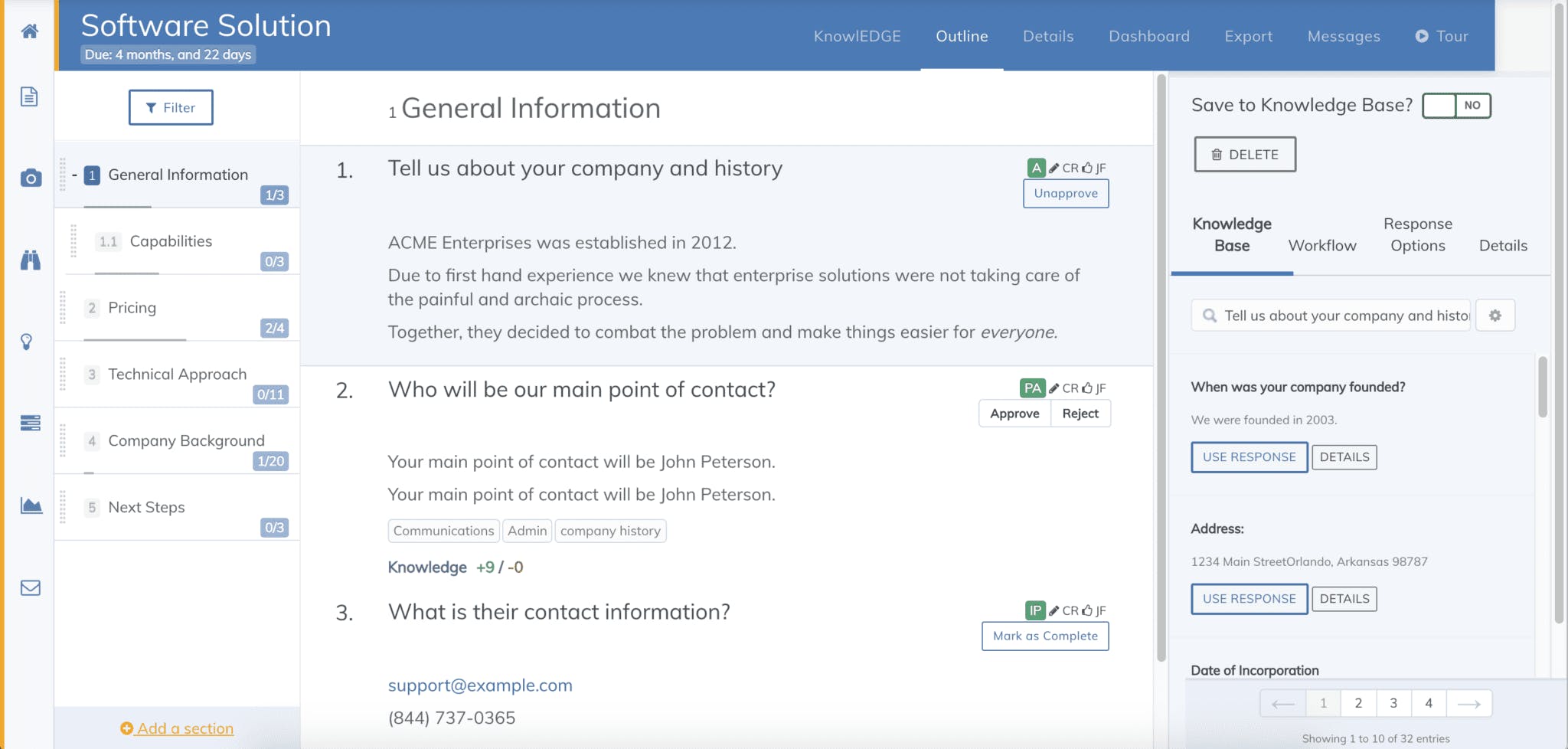When it comes to RFPs, simply following the instructions and providing all of the requested information can give you a big advantage. If you think that sounds deceptively simple, you’re right. As RFPs become more complex, proposal managers must take care to respond thoroughly to each question. At the same time, they work to build a compelling narrative and highlight differentiators — all while ensuring that the proposal meets a dozen or more requirements stated in the RFP. When all is said and done, the path from the RFP requirements to the resulting proposal may feel like a tangled web of information. Fortunately, creating a proposal compliance matrix serves as a map to keep you on track.
When omitting a single requirement may mean automatic disqualification, compliance is crucial. So, you must sift through the lines of the RFP to identify, manage and ensure compliance with each RFP requirement. The proposal compliance matrix enables quick cross-referencing between the information requested in the RFP and the corresponding responses in the proposal.
In this blog, we’ll cover the proposal compliance matrix. First, you’ll learn what exactly a proposal compliance matrix is. Then, we’ll walk step-by-step through how to create and use one to ensure your RFP responses meet every requirement. Finally, you can download a RFP compliance matrix template and view real-world examples to help you get started.
- What is a proposal compliance matrix?
- How to create and use a proposal matrix
- Proposal compliance matrix template and examples
What is a proposal compliance matrix?
A proposal compliance matrix is a grid-style tool used by proposal managers to identify, track and meet each requirement in a complex request for proposal (RFP). It may also be called an RFP compliance matrix, compliance traceability matrix or proposal matrix. No matter how it’s referred to, the matrix helps readers understand exactly how the vendor’s proposal aligns with the buyer’s requests.
What’s the purpose of a proposal compliance matrix?
To understand the value of the proposal compliance matrix, you must consider the buyer’s perspective.
The RFP has likely been issued by a procurement manager or department head seeking a solution to a problem. They know there are a lot of factors to consider and they need to be certain they’re choosing wisely. Accordingly, they invest time creating an RFP that organizes their needs and ensures objectivity.
Then, the buyer issues the RFP to a number of vendors who respond with their best offer. Because reading each proposal in detail is labor-intensive, the proposal evaluator performs an initial review. In this review, they quickly check each proposal to verify it meets the requirements stated in the RFP. Unfortunately, if a proposal doesn’t adhere to all of the submission guidelines, minimum criteria and content requirements, it may be thrown out.
After all of the time your team invested, missing a single requirement could mean that no one even ends up reading your proposal. It may seem harsh, but the buyer doesn’t have time to waste and they don’t want to partner with a business that doesn’t listen and follow instructions. With the stakes this high, you can’t afford to miss anything — which is why the proposal compliance matrix comes in handy.
The grid-style format lists each customer requirement, where it is stated in the RFP and where it is addressed in the final proposal. Indeed, this enables the proposal manager to track progress and quickly verify that all the necessary information is included.
Who uses them?
Generally, the proposal manager assigned to the RFP creates the compliance matrix and manages any updates to it. Contributors and SMEs may also use the proposal matrix when writing their responses. In addition, reviewers use it as a checklist during the final proposal review to verify compliance before submission. Consequently, it is helpful to save the RFP matrix in a shared, centralized location so that each member of the proposal team can refer to it as needed.
Benefits of using a proposal compliance matrix
Know every need before you bid
Most RFPs are long and detailed, composed of paragraphs of text and dozens of questions. Because requirements are often scattered throughout the document, they’re easy to miss. Therefore, consolidating the information to create a scannable list makes the customer’s expectations easier to understand. With a comprehensive set of needs, your team can confidently determine if you’re a fit and decide to bid or not to bid.
Prepare a complete plan
As you plan the proposal process, gather your team and assign tasks, the RFP compliance matrix can help. For example, you can use it as a guide when you create the proposal timeline and when you fill out your RACI matrix, assigning each requirement to the appropriate people.
Write relevant responses based on the stated requirements
Subject matter experts (SMEs) are always short on time, so it’s important to provide the information they need without distracting them with unnecessary details. Luckily, they can reference the proposal compliance matrix to quickly understand the customer’s needs
For example, an RFP software buyer may specify that they require Boolean search functionality in the introduction of the RFP. Unfortunately, without a proposal compliance matrix, a subject matter expert may not think to include that detail, if it isn’t mentioned again in the particular question that asks them to describe search capabilities.
Furthermore, if the SME wants to see if there is additional helpful context before they write their response, they can use information from the matrix to save time. It enables them to jump directly to the section and paragraph in the RFP that discusses the requirement.
Create a roadmap for reviewers
Finally, once the proposal is complete, it undergoes final review and approval. The proposal compliance matrix can be used as your checklist to ensure that each requirement is clearly addressed before submission.
How to create and use a proposal compliance matrix
Ultimately, the point of the proposal compliance matrix is to check the RFP, line by line, for each of the customer’s needs. This process is often referred to as shredding the RFP. You can shred the RFP using RFP management software or perform the process manually.
RFP compliance using proposal software
As technology advances, proposal software becomes more skilled at performing the RFP breakdown. Indeed, proposal automation can save time and shred an RFP in seconds. However, it can only go so far and proposal managers are still needed to inspect, verify and interpret the result.
From there, the proposal platform uses hyperlinks to pair RFP requirements with the corresponding responses, notifies users of assignments and tracks progress. Additionally, proposal managers, contributors and reviewers may add comments, collaborate and strategize throughout the response process.

How to create a proposal compliance matrix manually
Alternatively, shredding the RFP and creating a proposal compliance matrix takes more time, but is easy once you know what to do. All you need is a spreadsheet and your RFP.
Read through the RFP line by line. As you find requirements, add them to the first column of the spreadsheet in the order that they appear in the RFP. Then, as you read through the RFP, you’ll be able to spot requirements by looking for words like shall, will, must or should. In addition, include any questions that appear in the body of the RFP. Finally, check for information requests that use verbs like describe, list and explain.
For each requirement you identify, note the section, page and paragraph where it appears in the RFP. Then, use the next two columns to record our ability to comply (F – fully comply, P – partially comply, N – do not comply) as well as where the response to the requirement is located in your proposal (section, page and paragraph).

As you can imagine, it quickly becomes a lot of information. But, if you want to track more proposal data, adding columns to the compliance matrix is easy. For example, you could use the proposal matrix to manage task assignments or make notes for other team members. In addition, you may also add columns with information that helps SMEs write their responses, including win themes, differentiators or customer hot buttons. Indeed, some proposal teams use a column to draft or summarize their responses as well.
RFP compliance matrix best practices
To get the most out of your RFP compliance matrix, there are a few things you should know.
1. Create your matrix at the beginning of the proposal process
The proposal compliance matrix should guide you as you write the proposal outline and create your responses. If you wait until the end to create it, you’ll miss out on a lot of benefits.
2. Match the language used by your customer
Avoid confusion by using the exact language and terminology found in the RFP. Resist the urge to paraphrase or reword requests. If clarification is needed, use a notes column to collaborate with your team.
3. Continually update the proposal matrix
As you create your proposal outline and subsequent proposal drafts, the sections of your proposal may shift. Update the response location column of your matrix to reflect any changes.
4. Share your matrix with the proposal evaluator
While the proposal compliance matrix is typically created by the vendor for internal reference only, it can be helpful for the proposal evaluator as well. Indeed, it can serve as a cheat sheet and map to your proposal for them.
In fact, some procurement managers include a proposal compliance matrix template and require the vendor to fill it out and include it with their response. Alternatively, you can always proactively provide it. Just remember to remove any internal notes or comments before attaching it to your proposal.
Compliance matrix templates and examples
Association of Proposal Management Professionals (APMP) proposal compliance matrix template
APMP provides a wealth of resources for proposal managers including this proposal compliance matrix template. You can download the Excel file and customize the matrix to meet your needs.
Technical compliance matrix example
This proposal matrix example is from the Department of Administrative Services. They require participating vendors to complete it as part of their submission to streamline the evaluation process.
IT support services – Proposal compliance matrix example
Created by The Federal Proposal Experts (FPEX), this is a good example of what you might expect a public sector RFP compliance matrix to look like.
Strategic communication and graphic design RFP – RFP compliance matrix example
As a part of their RFP process, the Washington Metropolitan Area Transit Authority requires that interested vendors complete this RFP compliance matrix. Instructions request that vendors provide an explanation for any requirements the vendor is unable to meet or deems not applicable.
When it comes down to winning RFPs, complete compliance can make or break your proposal. So, whether you invest time to manually create your proposal matrix or use RFP software to automate the process, attention to detail always pays off.
For more insights and advice on how to improve the efficiency and effectiveness of your proposal process, check out these resources:
- The proposal process ebook
- 7 steps to creating winning RFP responses
- Winning together: The proposal team ebook

